The Boston Consulting Group Matrix: A Strategic Framework for Affiliate Marketers
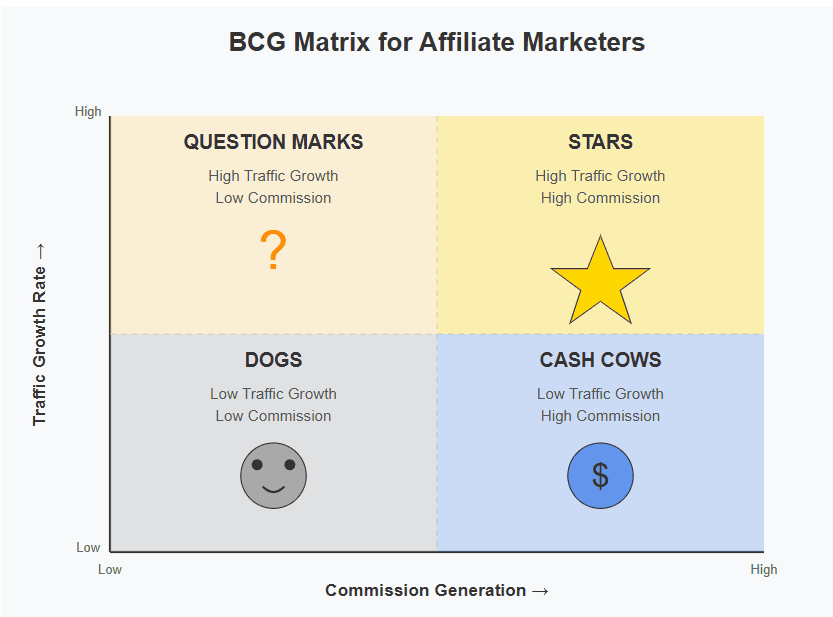
With limited time and resources, affiliate marketers must make calculated choices about where to focus their efforts—whether they’re managing a portfolio of niche sites or multiple content sections within a single authority site.
The challenge is familiar to every affiliate marketer: some content areas drive traffic but struggle with conversions, while others convert well but reach too few visitors. Some newer initiatives show promise but demand significant resources, while established content quietly generates reliable income.
Traditional marketing frameworks offer valuable perspectives that can bring clarity to these decisions. Among these frameworks, the Boston Consulting Group Matrix (BCGM) stands out as a particularly relevant tool for affiliate marketers seeking to optimize their digital assets and maximize commission revenue.
I built a rudimentary framework as far back as 2008 (published on Moz) and have refined it since and have been using it to advise affiliates over the last 15 years.
Understanding the BCG Matrix: Origins and Fundamentals
Developed by Bruce Henderson for the Boston Consulting Group in 1970, the Growth-Share Matrix (its formal name) was initially designed to help corporations manage their business units and product lines. Henderson recognized that companies needed a systematic approach to allocate resources across diverse business operations.
The genius of the BCG Matrix lies in its simplicity. By focusing on just two variables—market growth and market share—it creates a clear framework for strategic decision-making. This approach allows organizations to visualize their entire portfolio at once, identifying which products deserve investment and which might need reconsideration.
The matrix divides products or business units into four categories:
- Stars: High market growth, high market share
- Cash Cows: Low market growth, high market share
- Question Marks: High market growth, low market share
- Dogs: Low market growth, low market share
Each category suggests a different strategic approach, from investment and growth to harvesting or divesting. The framework’s enduring value comes from forcing strategic choices based on objective measurements rather than emotional attachments to particular products or initiatives.
Reimagining the BCG Matrix for Affiliate Marketing
While the original framework focused on traditional business units, the BCG Matrix translates remarkably well to affiliate marketing contexts. For affiliate marketers, individual websites in a portfolio or distinct content sections within a larger site can be plotted on this matrix to guide resource allocation decisions.

In the affiliate marketing realm, we can adapt the traditional axes:
Market Growth becomes Traffic Growth Rate: How quickly is traffic increasing to this affiliate site or content section?
Market Share becomes Commission Generation: How effectively does this site or content section convert visitors into affiliate commission revenue?
This adaptation maintains the spirit of the original framework while making it directly applicable to affiliate marketing decisions. If we were to outlay the sites in a portfolio, it could look something like this:
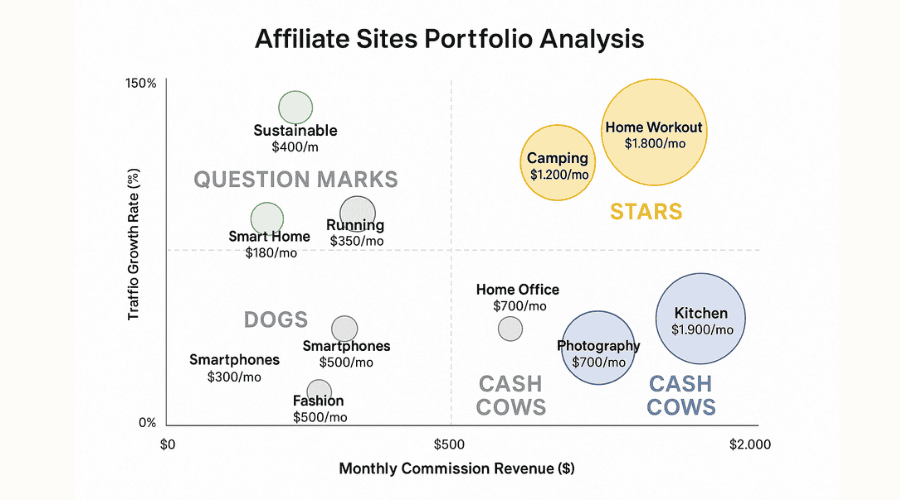
Affiliate Strategy By BCG Quadrant
Whether you’re managing multiple niche sites or comparing different product categories within a single authority site, this framework provides clarity. Let’s explore each quadrant in detail:
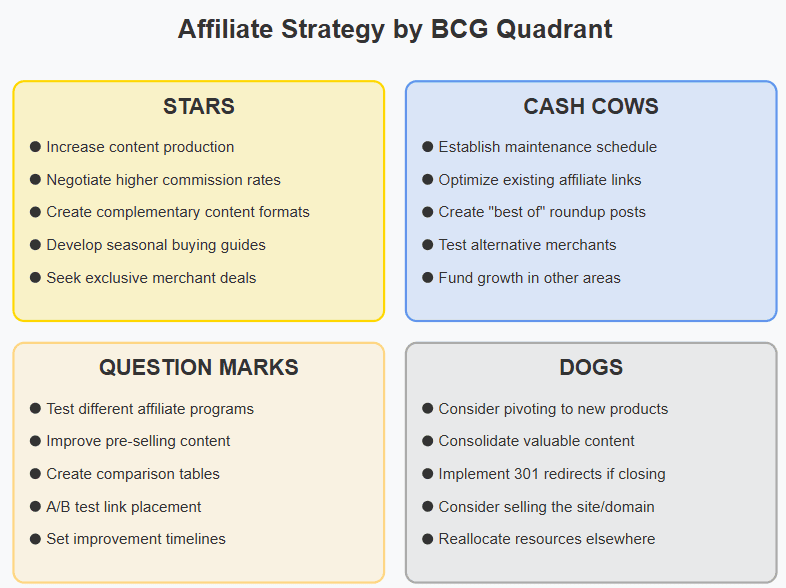
Stars: High-Growth, High-Commission Affiliate Assets
Stars represent your most promising affiliate sites or content sections. These assets are experiencing rapid traffic growth while simultaneously generating substantial commission revenue. They combine momentum with monetization—a powerful combination that merits continued investment.
Real-World Example: Consider an affiliate site’s home office equipment section that has seen a 180% increase in organic traffic over the past year while simultaneously achieving a 12% affiliate click-through rate and strong conversion rates with merchants. The content is resonating with audience purchase intent and effectively moving visitors toward merchant purchases.
Strategic Approach for Affiliate Marketers: Stars require continued investment to maintain their growth trajectory. This might mean:
- Expanding product reviews and comparisons in this high-performing category
- Negotiating better commission rates with merchants based on your proven performance
- Testing premium merchant partnerships with higher commission tiers
- Strengthening relationships with affiliate managers at key merchants
- Protecting search positions against competitive affiliate sites
- Developing content that targets the entire purchase journey, from awareness to decision
Key Insight for Affiliates: Stars offer valuable lessons about what’s working in your overall strategy. Analyze them deeply to understand patterns that might be replicated across other sites or content sections. Which types of products convert best? What price points drive the most commission? Which merchants offer the best combination of conversion rate and commission percentage? How can these insights guide your content development elsewhere?
Cash Cows: Stable, Commission-Generating Affiliate Assets
Cash cows represent the stalwarts of your affiliate portfolio. While they may not be experiencing dramatic traffic growth, these sites or content sections consistently generate significant commission revenue with minimal ongoing investment. They’ve achieved a level of stability that makes them reliable income producers.
Real-World Example: An affiliate site focusing on camera equipment reviews that ranks well for valuable buying-intent keywords and generates consistent commission revenue. Traffic has plateaued at about 30,000 monthly visitors, but the 8% click-through rate to merchants and strong average order value create a dependable income stream with only occasional content updates required.
Strategic Approach for Affiliate Marketers: Cash cows should be maintained efficiently to preserve their commission-generating capacity:
- Implement a quarterly content refresh schedule focusing on updating prices, availability, and product information
- Regularly test different affiliate link placements and call-to-action formats to optimize click-through rates
- Monitor competitor commission rates and renegotiate with merchants when appropriate
- Capitalize on seasonal buying trends with timely content updates before peak periods
- Consider using some commission income to fund more speculative investments in potential stars
- Watch for merchant program changes or product discontinuations that could threaten revenue
Key Insight for Affiliates: Cash cows provide the financial foundation that enables experimentation elsewhere. These stable earners allow you to weather algorithm updates or merchant program changes while pursuing growth initiatives. Look for ways to systematize their maintenance, perhaps through virtual assistants who can regularly check for broken links or outdated information.
Question Marks: Growing but Under-Converting Affiliate Assets
Question marks (sometimes called “problem children”) present interesting dilemmas for affiliate marketers. These sites or content sections show promising traffic growth but haven’t yet translated that audience into significant commission revenue. They represent potential that hasn’t been fully realized.
Real-World Example: A fitness equipment affiliate site that has rapidly gained traffic through informational content about home workouts but struggles with affiliate conversion. Despite attracting 50,000 monthly visitors, the site generates minimal commission income because visitors consume the workout information but rarely click through to purchase the recommended equipment.
Strategic Approach for Affiliate Marketers: Question marks require careful analysis and strategic decisions:
- Experiment with different affiliate programs and merchants to find better conversion potential
- Test various affiliate link placements within the content flow
- Analyze whether visitors have purchase intent or are purely information-seeking
- Consider introducing different product categories that better match audience needs
- Implement content upgrades that bridge informational content to purchase decisions
- Create comparison tables, buyer’s guides, or other conversion-focused content formats
- Negotiate exclusive discount codes with merchants to incentivize purchases
- Set specific conversion improvement targets and timelines before reallocating resources
Key Insight for Affiliates: Question marks often suffer from a misalignment between content type and commercial intent. The audience may be valuable but at the wrong stage in their buying journey. By creating content that naturally bridges from information to purchase consideration (such as “What to look for when buying…” guides), you can often transform these traffic-rich assets into revenue generators.
Dogs: Low-Performance Affiliate Assets
Dogs represent the underperformers in your affiliate portfolio. These sites or content sections show minimal traffic growth and generate little commission revenue, raising questions about their continued value to your overall strategy.
Real-World Example: An affiliate site focused on smart home technology that has failed to gain traction despite considerable content investment. After eighteen months, the site attracts fewer than 100 daily visitors and has generated less than $200 in total affiliate commissions, yet still requires domain renewal, hosting costs, and occasional content updates.
Strategic Approach for Affiliate Marketers: Dogs demand honest assessment and decisive action:
- Evaluate whether pivoting to different product categories within the same niche could revitalize performance
- Consider moving valuable content to more successful affiliate sites in your portfolio
- Implement 301 redirects to preserve any SEO equity if shutting down a site
- For underperforming sections within a larger site, repurpose the URL structure for more promising content
- Assess whether established backlinks or aged domain authority provides value despite poor performance
- Analyze whether merchant programs themselves are problematic (low commission rates, poor conversion rates)
- Make the difficult decision to discontinue investment if turnaround prospects are poor
Key Insight for Affiliates: The emotional attachment to affiliate sites can be surprisingly strong, especially if you’ve invested significant time creating content. However, recognizing and addressing underperforming assets is crucial for portfolio health. Every hour spent updating a “dog” site is an hour not spent on a potential “star.” Sometimes selling these sites on marketplaces like Flippa or Empire Flippers—even at a modest price—is better than continued investment in a losing proposition.
Practical Application: The BCG Matrix for Affiliate Portfolio Management
Implementing the BCG Matrix approach for your affiliate sites or content sections involves several key steps tailored to the affiliate marketing model:
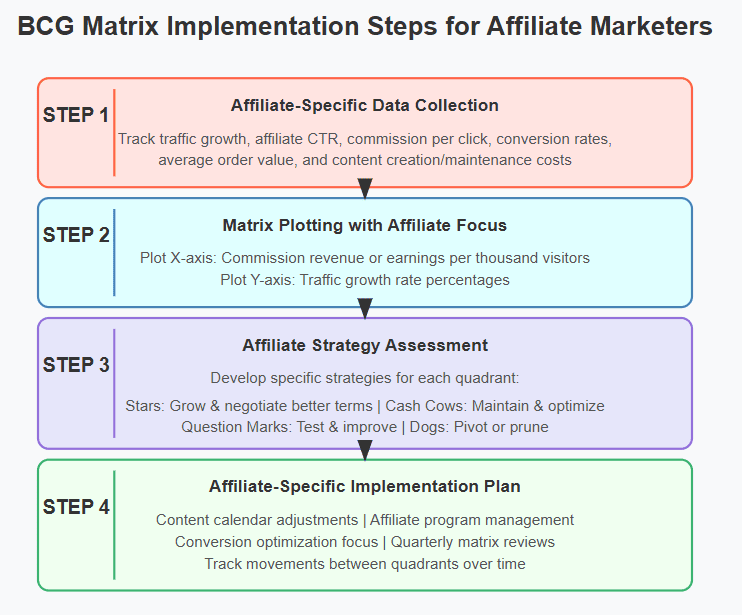
1. Affiliate-Specific Data Collection
Begin by gathering performance data across your affiliate properties. Focus on metrics that matter specifically to affiliate marketing:
- Traffic growth rates (month-over-month or year-over-year)
- Affiliate link click-through rates (CTR)
- Earnings per click (EPC)
- Commission totals by merchant or product category
- Content production and maintenance costs
- Conversion rates provided by merchant reporting
- Average order value (AOV) trends
- Content update frequency requirements
For affiliate marketers using a single site with multiple content sections, segment your analytics data by content category or product type to enable meaningful comparisons.
2. Matrix Plotting with Affiliate Focus
Create a visual representation of your affiliate portfolio by plotting each site or content section on the matrix. For the two axes:
- X-axis (Market Share): Use affiliate commission revenue or earnings per thousand visitors (EPMV)
- Y-axis (Market Growth): Use traffic growth rate percentages
Consider adding visual elements to represent:
- Circle size: Total affiliate revenue
- Color coding: Different affiliate programs or merchant categories
- Labels: Primary traffic sources (organic, social, email)
This visualization quickly reveals where your affiliate efforts are succeeding or struggling in a way that raw data might obscure.
3. Affiliate Strategy Assessment
With your matrix complete, assess each quadrant to develop appropriate affiliate strategies:
For Stars (High Growth, High Commission):
- Can you negotiate higher commission rates based on your performance?
- Which additional products complement your current successful promotions?
- How can you replicate this success with similar affiliate programs?
- Should you develop custom landing pages for high-converting affiliate offers?
- Can you secure exclusive deals or coupon codes from merchants?
For Cash Cows (Low Growth, High Commission):
- What minimal maintenance schedule will preserve rankings and commissions?
- Are there seasonal optimizations to implement before peak buying periods?
- Can you test higher-commission alternatives to current merchant partners?
- Would creating comparison content between competing products increase conversions?
- How can you leverage this content’s authority to boost related sections?
For Question Marks (High Growth, Low Commission):
- Are you promoting the right products for this audience?
- Could higher-ticket items increase commission without hurting conversion rates?
- Would different affiliate networks offer better terms for similar products?
- Is the content structure effectively leading visitors toward purchase decisions?
- Would more prominent affiliate link placement improve click-through rates?
- Could better pre-selling in the content improve merchant conversion rates?
For Dogs (Low Growth, Low Commission):
- Could switching to different product categories revitalize this content?
- Is the traffic quality issue or a conversion issue?
- Would this content perform better on another site in your portfolio?
- Are the merchants themselves problematic (poor user experience, low commission)?
- What is the opportunity cost of maintaining this content?
4. Affiliate-Specific Implementation Plan
Transform your analysis into concrete action plans tailored to affiliate marketing:
Content Calendar Adjustments:
- Increase content production for Star sites/sections
- Create maintenance schedules for Cash Cows
- Develop conversion-focused content for Question Marks
- Minimize new content for Dogs unless implementing a strategic pivot
Affiliate Program Management:
- Reach out to affiliate managers of Star merchants to negotiate better terms
- Seek exclusive promotions for high-performing content
- Test alternative merchants for underperforming sections
- Consider direct relationship opportunities for top-converting products
- Implement systematic A/B testing of affiliate link placements
- Create custom comparison tables for product categories
- Develop better pre-selling content that bridges information to purchase
- Test various call-to-action formats and positions
Revisit your matrix quarterly to track changes and adjust strategies accordingly. The affiliate landscape changes rapidly with new products, commission structure changes, and search algorithm updates.
Advanced BCG Applications for Affiliate Marketers
While the standard BCG Matrix provides valuable insights, affiliate marketers can enhance its utility through several advanced applications tailored to their business model:
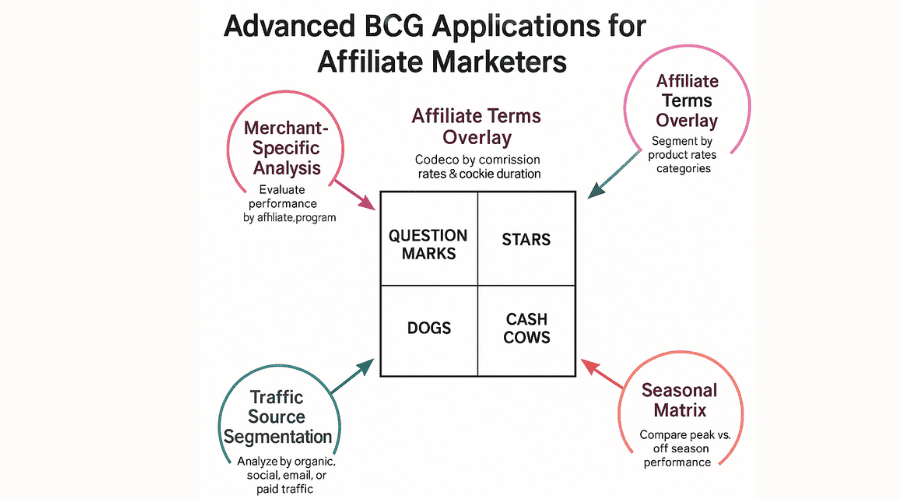
Merchant-Specific BCG Analysis
Create separate matrices for each major affiliate merchant or network you work with. This merchant-level view reveals important patterns:
- Which merchants consistently appear in your Star quadrant across different content areas?
- Are certain affiliate programs perpetually in the Dog quadrant regardless of content quality?
- Which networks provide the most Stars relative to your effort?
This analysis helps identify whether performance issues stem from your content approach or the merchants themselves, guiding decisions about which affiliate relationships to prioritize.
Product Price Point Analysis
Develop a matrix that segments your affiliate content by product price points rather than by site or section:
- Budget products (<$50)
- Mid-range products ($50-$200)
- Premium products ($200-$1000)
- Luxury products ($1000+)
This view often reveals surprising patterns about which price categories deliver the best commission returns relative to traffic, helping you focus future content development on the most profitable segments.
Affiliate Program Terms Overlay
Enhance your matrix by color-coding or adding symbols to represent different affiliate terms:
- Commission percentage tiers
- Cookie duration length
- First vs. last click attribution models
- Performance bonuses or tiered structures
- Payment reliability and timing
This enhanced view helps identify whether high-performing sections succeed because of superior content or more favorable affiliate terms, informing both content and partnership strategies.
Seasonal Matrix Comparisons
For affiliates in seasonal niches (like holiday gifts, summer products, or back-to-school items), create matrices for different seasonal periods:
- Peak season performance
- Off-season performance
- Year-round performance
This comparison reveals which content areas maintain value throughout the year versus those that spike during specific periods, helping you develop a more balanced content strategy that provides consistent income.
Traffic Source Segmentation
Develop matrices that segment your affiliate content by primary traffic source:
- Organic search traffic
- Social media referrals
- Email marketing clicks
- Paid traffic
This view often reveals that certain traffic sources convert dramatically better for affiliate offers, helping you align your traffic acquisition strategy with your most profitable conversion paths.
Common Pitfalls in Applying the BCG Matrix
While powerful, the BCG Matrix approach comes with potential pitfalls that digital marketers should avoid:
Premature Abandonment of Question Marks
Question Marks often represent new initiatives that haven’t had sufficient time to establish monetization patterns. Giving up too quickly on promising traffic generators can mean missing future Stars. Consider setting longer evaluation timelines for properties showing strong audience growth.
Overinvestment in Dogs Based on Emotional Attachment
Many digital marketers develop emotional connections to early projects or creative initiatives, leading to continued investment despite poor performance. The framework’s value comes from counterbalancing this tendency with objective performance metrics.
Neglecting the Qualitative Dimension
Not all traffic is equal in quality or conversion potential. A property might show modest traffic growth but attract highly qualified visitors with strong purchase intent. Supplement the quantitative matrix with qualitative audience analysis to avoid overlooking valuable niche properties.
Focusing Exclusively on Present Performance
The matrix captures current performance but doesn’t inherently account for future market potential. A property might currently sit in the Dog quadrant but address an emerging market with significant future potential. Consider adding a “market potential” overlay to your matrix for more forward-looking decisions.
Strategic Portfolio Thinking for Affiliate Success
The BCG Matrix offers affiliate marketers a powerful framework for making difficult but necessary strategic decisions. Whether you’re managing multiple affiliate sites or diverse content sections within a larger site, this approach cuts through emotional attachments and subjective impressions to reveal where your true opportunities lie.
Key Benefits for Affiliate Marketers
- Time Optimization: As an affiliate marketer, your scarcest resource is time. The BCG Matrix helps ensure you invest that time where it delivers the greatest returns, rather than spreading yourself too thin across underperforming content areas.
- Commission Maximization: By identifying which product categories and merchants consistently deliver the best commission returns, you can focus content development on your most profitable partnerships.
- Portfolio Diversification: The matrix visualization quickly reveals dangerous dependencies—whether on a single site, content category, or merchant relationship—enabling more strategic risk management.
- Affiliate Relationship Leverage: Understanding which content truly drives conversions gives you leverage when negotiating commission rates or exclusive deals with merchants.
- Objective Decision-Making: The framework replaces gut feelings with data-driven insights, helping overcome the emotional attachment that often keeps affiliate marketers investing in underperforming content.
Implementation Recommendations
For affiliate marketers looking to implement this approach:
- Start Simple: Begin with a basic matrix plotting traffic growth against commission revenue for your major content areas or sites.
- Be Ruthlessly Honest: The framework only works if you accurately categorize your content without wishful thinking about future potential.
- Set Concrete Timelines: For Question Marks, establish specific improvement targets and deadlines to prevent indefinite resource drain.
- Review Regularly: Affiliate marketing changes rapidly with algorithm updates, product releases, and commission structure changes. Quarterly matrix updates keep your strategy aligned with current realities.
- Act Decisively: The insights from your matrix analysis have value only if you implement the indicated changes, even when they involve difficult decisions about content you’ve worked hard to create.
In an affiliate space increasingly dominated by authority sites and sophisticated competition, strategic portfolio management becomes a critical differentiator. The most successful affiliate marketers aren’t necessarily those who create the most content or promote the most products—they’re those who strategically concentrate their efforts where the return on investment is highest.
By applying the BCG Matrix to your affiliate marketing efforts, you transform from a tactical content creator into a strategic portfolio manager. This mindset shift enables more efficient resource allocation, higher commission revenue, and ultimately, a more sustainable and profitable affiliate business.






